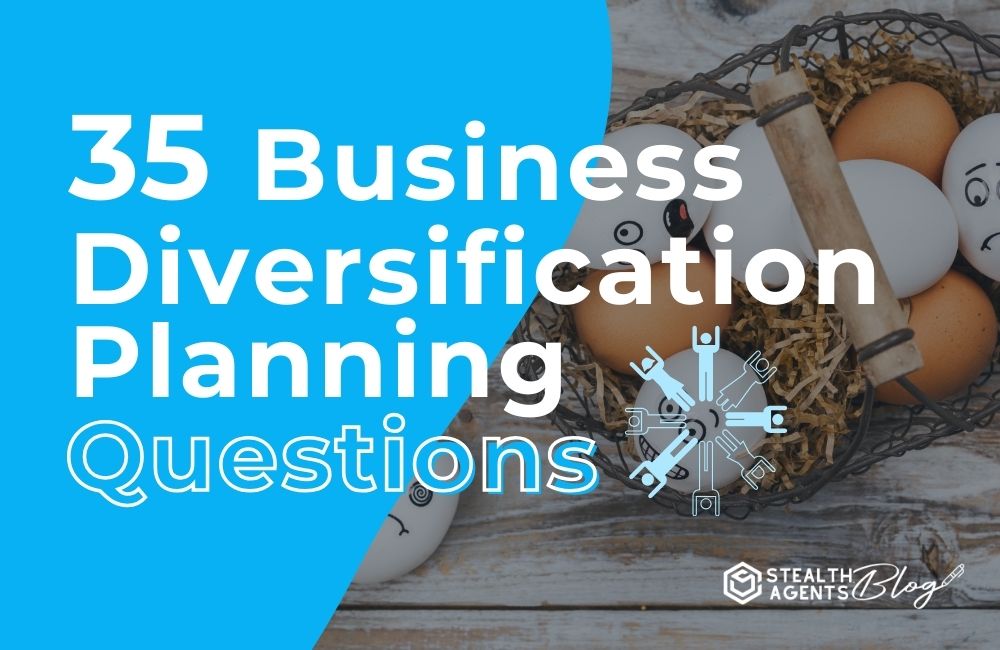Have you ever felt that your business could achieve more? We’ve all envisioned our companies soaring to new heights, like a startup entrepreneur with a billion-dollar app idea. But realizing those ambitions requires more than just dreaming; it demands careful planning, risk assessment, and the courage to diversify.
Diversification is the business equivalent of casting a wide net. Rather than relying on just one product, service, or market, you’re expanding your reach, attracting new customers, and safeguarding against market changes. But how do you start expanding without overreaching or losing focus?
Here’s where our comprehensive checklist comes into play. Alongside key strategic planning questions, we’ve included essential Business Disaster Recovery Planning questions to help you prepare for and navigate through unexpected challenges. Use these questions to review, refine, and revolutionize your approach, ensuring your business is both versatile and resilient.
Why Diversification is important?
Business diversification can be a powerful growth driver, but it’s not without pitfalls. Before you plunge into new ventures, it’s imperative to lay a solid foundation.
One way to do this is by asking the right questions. Let’s drill down into 35 questions to prompt your diversification planning and ensure you’re well-prepared for the journey ahead.
1. What Does Success Look Like for Diversification in Our Context?
Before executing get to know the product diversification strategy, it’s important to pin down what success means for your particular organization. Is it about revenue growth, market share, or expanding your customer base?
2. How Is Diversification Aligned with Our Current Mission and Values?
Expansion shouldn’t mean straying from your roots. Consider how any diversification plans align with your original mission and company principles.
3. What Are the Immediate and Long-term Goals for Diversification?
Clearly define your near and far-reaching targets. This could include a specific percentage growth within the first year and solidifying a new segment within five years.
4. What is the Financial Resources Snapshot for Expanding Into New Territories?
Diversification requires capital. You need to assess your financial health and resources you’re willing to allocate to the new venture.
5. Are We Aware of the Major Market Trends and Demands That Could Affect Our Business?
It’s critical to monitor the winds of change in your market. Look at trends, such as technology shifts or changing consumer behavior, that could present opportunities or threats.
6. Have We Taken a Thorough Look at Our Current Product or Service Performance?
An honest assessment of your current offerings is a good precursor to exploring new ventures. Understanding what is working and what may need to be adjusted can inform your diversification plans.
7. Do We Understand the Importance of Brand Positioning in Diverse Markets?
Your brand’s reputation is a non-negotiable asset in diversification. Consider how it will be positioned in new markets and ensure it stays true to your story.
8. How Will Diversification Affect Our Current Customer Base?
It’s necessary to anticipate the effects diversification might have on your existing customers. Will it complement their needs, or will it cause confusion?
9. What Are the Risks Associated with Not Diversifying?
Sometimes the biggest risk is not taking any risks. Delve into the potential dangers of sticking to the status quo.
10. What Could Be Our Competitive Edge in New Diversified Arenas?
Explore what sets you apart from the competition in areas you’re considering diversifying into. Capitalize on these strengths.
11. How Does Our Leadership Structure Need to Shift to Support Diversification?
Diversifying often means reorganizing. Analyze if your current leadership structure is conducive to expansion or needs alteration.
12. What Will Be the Implications for Our Current Employees?
The people who work for you are the backbone of your company. Consider how diversification will affect them and plan to communicate the changes effectively.
13. What Will Be Our Marketing and Sales Strategies for Diversification?
Your current marketing and sales tactics might not cut it in a new market. Develop plans that appeal to the consumers of your diversified offerings.
*advertisement*
Tired & Overwhelmed With Administrative Tasks?
Hire A Top 1% Virtual Assistant From Stealth Agents!

Sign Up Below & Hire A Top 1% Virtual Assistant
Rated 4.7 Stars Serving Over 2,000+ Customers.
Hire Top 1% Virtual Assistants For $10-$15 Per Hour
Ask About Our 14 Day Trial!
*advertisement*
14. Are There Any Regulatory Hurdles to Anticipate in New Markets?
Regulations can be drastically different in varied markets. Ensure you’re aware of and prepared for any legal hoops.
15. Have We Established Key Performance Indicators (KPIs) for Our Diversification Efforts?
How will you measure success? Outline KPIs that will provide clear indicators of growth and reception in new territories.
16. What Will Be Our Supply Chain Strategy for New Ventures?
Diversification can complicate your supply chain. Figure out how to efficiently manage resources and delivery for new lines of business.
17. How Do We Manage the Intellectual Property Issues When Diversifying?
Ensure that your intellectual property is protected when diversifying, and understand how to navigate the IP landscape in diverse markets.
18. How Do We Communicate Diversification Plans with Stakeholders?
Communication is key when making big moves. Craft a plan to keep stakeholders in the loop and address any concerns.
19. Do We Have a Contingency Plan for Potential Diversification Failures?
No plan is foolproof. Have a contingency plan in place should your diversification efforts not pan out as expected.
20. How Will Diversification Impact Our Ability to Innovate Across the Business?
Innovation drives growth. Consider how diversification will impact your company’s culture of innovation and make adjustments as needed.
21. What Technology Infrastructure Will Support Diversification Efforts?
Modern businesses are as good as their tech. Evaluate the kind of infrastructure you’ll need to support diversification and make the necessary investments.
22. What Kind of Cultural Preparation Is Needed for Entering New Markets and Industries?
Different markets have different cultures. Be prepared to adapt your company culture to resonate with new customers and employees.
23. What Kind of Training Programs Are Necessary for Our Teams in Diversified Areas?
Expertise doesn’t always transfer across different industries. Develop training programs to equip your team for success in new ventures.
24. Are We Prepared for the Increased Workload and How Will We Manage It?
Diversification usually means more work. Plan for the human resources needed to manage increased operations.
25. Will Diversification Impact Our Environmental and Social Responsibilities?
With society’s growing emphasis on corporate responsibility, consider how your diversification moves can impact the environment or communities and put measures in place to address them.
26. What Experiments and Tests Should We Run Before Major Diversification Launches?
Before going all-in, test the waters. Plan out initial small-scale experiments to gauge potential success in new areas.
27. How Will We Monitor and Respond to Marketplace Feedback?
The market’s response to your diversification is crucial. Establish systems for monitoring feedback and the agility to respond to it.
28. Do We Have the Agility and Flexibility to Pivot in Our Diversification Moves?
Markets can be unforgiving. Ensure your company culture is one that can pivot quickly in response to changes and failures.
29. What Legal and Ethical Considerations Do We Need to Address Before Diversifying?
Legal and ethical nuances in different sectors can be complex. Get ahead by understanding them beforehand.
30. How Will We Measure the Impact of Diversification on Our Reputation?
Reputation is everything. Plan how to measure and adjust for the impact of your diversification moves.
31. Do We Have a Comprehensive Exit Plan if New Ventures Don’t Work Out?
Sometimes, you just have to walk away. Draft an exit plan for new diversification arms that fail to take off.
32. What Role Will Partnerships Play in Our Diversification Strategy?
Partnerships can be a shortcut to success. Determine the role they’ll play in your diversification strategy and start scouting.
33. Do We Have the Necessary Engagements and Negotiation Skills for Potential Diversification Partnerships?
Sometimes, it’s not just what you know; it’s who you know. Ensure you have the negotiation skills and networks to secure valuable partnerships.
34. How Will We Integrate New Ventures with Our Existing Business?
Integration can be tricky. Plan how you’ll weave new ventures into your existing business for a seamless customer experience.
35. How Sustainable Is Our Diversification Plan Over the Long Haul?
Finally, take a step back and look at the big picture. Is your plan sustainable over the long term, and does it promote the growth of a healthy business model?
Conclusion
Diversification is more than a buzzword; it’s a strategic move that, when executed well, can bolster your business’s resilience and growth. By considering these 35 questions, you’re not just thinking about expanding. You’re creating a roadmap for excellence in new markets, products, and services. Remember, in business, the only risk you can’t afford to take is standing still. Engage, plan, and diversify wisely.










